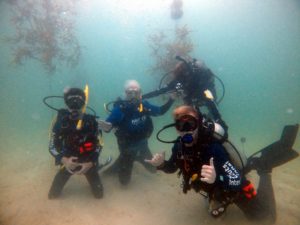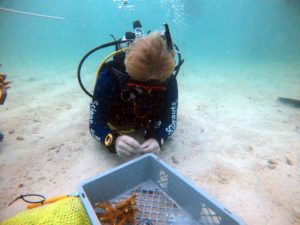My favorite experience so far on the SCUBAnauts International Summerland Key Trip was the coral restoration work we did with the Mote Marine Lab. We dove down to a depth of around 25-30 feet into Mote’s coral nursey. The nursery is located close to Looe Key Special Protected Area (SPA) and is considered its own special research area.

Hayden and his dive buddies pose with Mote CEO Micheal Crosby after finishing a complete coral “tree” in the nursery.
We were given one of three tasks to complete by an experienced diver. The first job was fragging overgrown coral. Essentially, we broke some pieces off a large colony with the intention of moving them to a new tree. After this, the broken pieces, called fragments, were passed to a different group of people who had to tie monofilament line to the coral, securing it. Then, the final group hung the coral on new coral trees.
This entire process was very relaxing, sitting on the ocean floor and doing your task as dozens of friendly yellowtail snapper swim by. I personally enjoyed hanging the coral on the new trees the most, and I was extremely proud when my group finished hanging 100 pieces of coral, completing our tree. It was a lot of fun watching the friendly yellowtails swim around us, interested in our work.
Not Your Average Dive Setup
It was also a different experience adding additional weights to our dive kit in order to keep us anchored on the ocean bottom. We did this because we had no need to maintain or usual neutral buoyancy, and it is much easier to tie mono lines on the ground.
The only grievance I had with the work was that the first day had a pretty strong current. This required constant adjusting to stay close to our workstation. The second day’s conditions were close to perfect however. There was almost no current or surge and we were able to focus entirely on our task. The visibility was alright, and we were able to see the other groups around us easily.

Hayden ties monofilament line around a coral fragment so it can be hung on a coral tree where it will grow rapidly.
During the 6 dives, I was able to get a good look of the entire sanctuary. There was a small man-made reef constructed with cinder blocks which attracted a surprising amount of life, including hogfish, crabs, and remoras. All in all, the Mote Nurseyr was an awesome place to have fun, see new things, and help out.
— Hayden R., Naut-in-Training, Orlando Chapter

